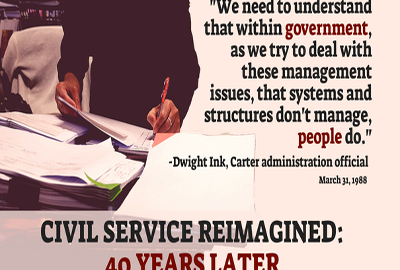
Ready for some more reforms?
Forty years after the civil service was officially “reformed” by the Carter administration, a new team with very different ideas about the role of government...
Forty years after the civil service was officially “reformed” by the Carter administration, a new team with very different ideas about the role of government and regulations is looking to do some reforming of its own.
Some can be done administratively, or by executive order. Others will require congressional approval.
One of the primary goals of the 1978 reform was to create the Senior Executive Service. The SES was to be the cream of the civil service crop. Grades 16, 17 and 18 were eliminated while the so-called “supergraders” were given the choice of remaining in grade permanently, it was stressed, or joining the SES.
Most got the message and opted for the new SES, which was supposed to make it easier to reward the best and deal with the not-so-good. Mobility was stressed as SES members would be moved within their own agencies, given assignments in other agencies and in different parts of the country.
So what’s the state of the federal career civil service 40 years after it was fixed?
The workforce has changed dramatically. It is older, better educated and serving a much larger customer base with roughly the same number of people. Forty years ago, six of the top 10 occupations in government were clerical. Today there is only one clerical designation in the top 10 occupations. A comparison can be found in yesterday’s column.
Last week, Federal News Radio’s Nicole Ogrysko wrote a series about the 40th anniversary of the last big round of reforms. It is worth reading both as a record of where you, as a fed or retiree, have been and where you may be headed. She’s my guest on today’s Your Turn radio show. We’ll talk about the past, present and future of the civil service.
Also joining the show is Senior Digital Editor Michael O’Connell, who will be talking about the amazing world of podcasts as a way to keep you posted and maybe help you get ahead in your federal career. That’s at 10 a.m. EDT on www.federalnewsradio.com or on 1500 AM in the D.C. area.
Nearly Useless Factoid
By Amelia Brust
About half of all the world’s oxygen is produced by algae.
Source: Scripps Institution of Oceanography
Copyright © 2024 Federal News Network. All rights reserved. This website is not intended for users located within the European Economic Area.
Mike Causey is senior correspondent for Federal News Network and writes his daily Federal Report column on federal employees’ pay, benefits and retirement.
Follow @mcauseyWFED





